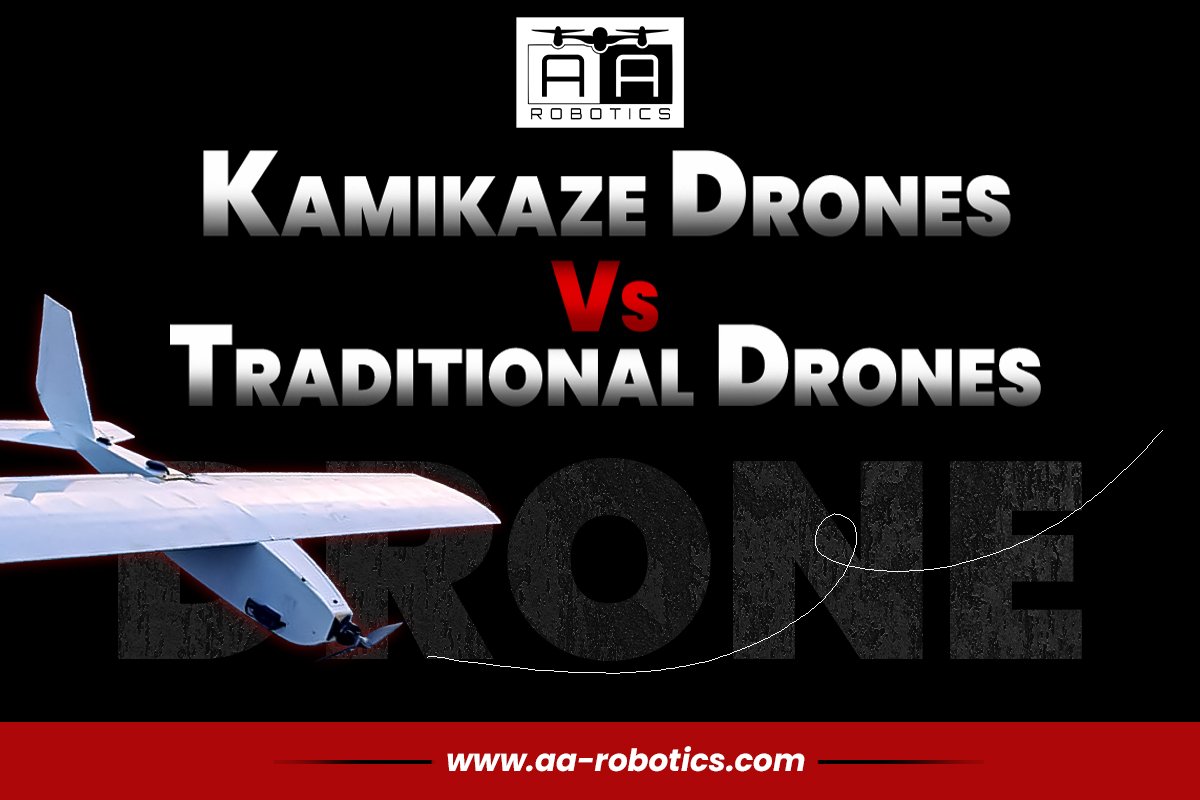
Kamikaze Drones Vs Traditional Drones
Lingering munitions, another name for kamikaze drones, are a particular kind of unmanned aerial vehicle (UAV) that is fitted with the relay work on the intended target. Kamikaze drones are disposable, in contrast to regular drones, which are intended to be recovered and repurposed after doing their task. Their task is to deliver a quick payload with accuracy and decisiveness. Let’s explore with AA Robotics how drones’ changing the era of defense systems with their target. Kamikaze drones are an essential component in asymmetric warfare, providing a number of benefits that conventional drones cannot match.
The Evolution of Kamikaze Drones Against Traditional Drones
Despite the fact that the idea of kamikaze drones is not new, its use in big-scale wars has expanded lately, in particular in regions in which traditional army operations are taken into consideration to be too cheap-priced or volatile. Kamikaze Drones are appealing due to their affordability, simplicity, and performance. They can be utilized in target towards essential goals or in mass work to overpower rivals. This makes them mainly useful in situations where extra-traditional drones might be prohibitively expensive or too susceptible to anti-aircraft defenses.
The popularity of kamikaze drones may be attributed to advancements in both drone generation and the miniaturization of explosives. These drones are usually smaller than their conventional counterparts, making them more difficult to stumble on and intercept. Their capability to loiter inside the air for extended intervals permits them to gather intelligence and identify targets before initiating any target. Once a target is placed, the drone descends hastily, striking with lethal force. This approach of operation has tested notably effective in conflicts across the Middle East, eastern Europe, and different regions wherein non-conventional battle methods are employed.
Kamikaze Drones’ Benefits Over Traditional Drones

The employment of kamikaze drones for anti-air defense is another important application. As a kind of aerial self-defense, these drones may target hostile planes, helicopters, or other drones. This makes them an invaluable tool for preventing a rival from having air supremacy, particularly when combined with other air defense systems.
Kamikaze Drones Work In Comparison To Traditional Drones
While it comes to modern warfare, kamikaze drones are advanced to traditional drones in a number of ways. Their affordability is, in a way, the largest and most glaring benefit. Traditional drones can be extraordinarily costly to create and function, specifically those that can be equipped with advanced sensors and weaponry. Conversely, kamikaze drones are made to be less expensive and effortlessly disposed of. Because of this, armies can additionally use them in huge portions without being worried about the economic fallout from losing them in war. Smaller nations or non-country actors that do not have the finances to perform a fleet of traditional drones may additionally discover kamikaze drones to be an appealing opportunity because of their low value.
The capacity of kamikaze drones to keep away from detection is considered one of their primary advantages. These drones are challenging to perceive with conventional radar systems because of their tiny size and low-altitude flying patterns. They are therefore perfect for breaking into hostile airspace and launching unexpected strikes on important targets. Conventional drones are more susceptible to interception, even though they can still avoid detection since they are often bigger and more noticeable on radar.
Operational Performance Of Traditional Drones Compared To Kamikaze Drones
The use of kamikaze drones is rather simple. After being released, the drone is going right into a loitering segment while it seeks a goal and monitors a predetermined region. Usually, these drones have cameras or different sensors installed, which allows them to realize viable objectives from the air. While some kamikaze drones may be operated remotely by an operator, others function independently and are pre-programmed with target coordinates. After locating a target, the drone launches its target mode. It moves quickly in the direction of its goal, frequently making evasive moves to get around opponent defenses.
Conclusion
With their clear benefits over conventional drones in terms of price, efficacy, and tactical flexibility, kamikaze drones work in a new era of cutting-edge conflict. They’re a crucial tool in army operations all over the world due to their potential to hover in the air, keep away from being aware, and strike with lethal accuracy. Kamikaze drones are likely going to be used in an increasing number of wars within the future as drone generation advances. Although kamikaze drones have carved out a special place for themselves as a totally mighty precise aerial vehicle, traditional drones will still be useful for reconnaissance and surveillance tasks. How do kamikaze drones work in military operations is a matter of keen observation in today’s world. It will remain a critical aerial vehicle for militaries in the future years because of their potential to impede operations and perform treasured objectives.
Kamikaze drones are disposable and designed to impact anything that is targeted, unlike normal drones, which are reusable
Yes, the kamikaze drones are relatively cheaper because it doesn’t require the retrieval and maintenance of in the long term.
Kamikaze drones can be guided autonomously or be piloted through remote control, just like the normal drones.
Yes, though they are not designed for a one-time mission like special kamikaze drones.



1 Comment
Trena
Hurrah! At last I got a web site from where I be able to truly
get helpful data regarding my study and knowledge.!